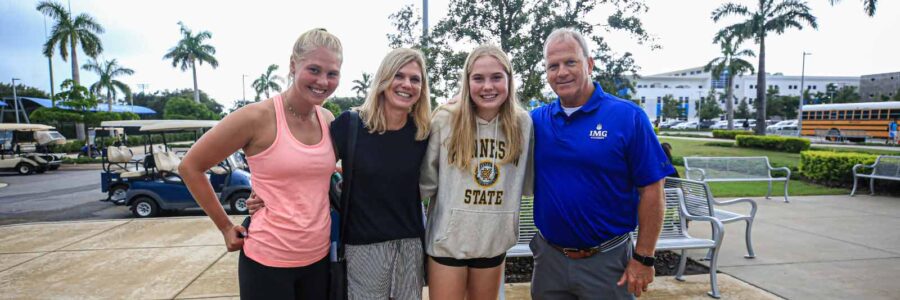
As a parent, you play a crucial role in your student-athlete’s college recruiting journey. Your guidance and support can make all the difference as they navigate this important decision. While it’s natural to focus on the athletic side of recruiting, there are many other factors to consider—what if your student-athlete gets injured, loses interest in competing, or simply wants a change? It’s important to help your athlete find a college where they’ll thrive both on and off the field—academically, socially, and financially.
This guide is designed to help you understand how to best support your student-athlete at every stage of the college search and recruiting process, so you can work together to find the right fit in all areas.
Table of Contents
All-Access Workshop: The Parent’s Role in College Recruiting
In this free all-access video workshop, NCSA Director of Recruiting Education Paul Putnam explores the important and evolving role parents play in the college recruiting process. He breaks down how responsibilities differ between parents and student-athletes, and offers practical advice on how to best support your child every step of the way. Watch the workshop now.
Browse more of our free all-access recruiting workshops here.
Finding the right division level for your athlete’s talent
Finding the right division level that matches your student-athlete’s talent can be challenging. It requires you to know what it takes to compete at each division level and understand your athlete’s talent and potential.

Follow these four steps:
- Research NCAA division levels, NAIA, and JUCO programs with your athlete.
- Get your athlete evaluated by their high school/club coach to determine their skill level.
- Review college rosters to see how your athlete’s skills compare.
- Attend college competitions to identify areas for improvement.
Each NCAA division level is unique, with its own recruiting rules, calendar and caliber of competition. Before you can decide what college programs your athlete should consider, you first need to understand your options. Sit down with your student-athlete to research the three NCAA division levels, as well as NAIA and JUCO programs. You might be surprised to learn that you can find Division 1 quality competition at the Division 2, 3 and NAIA levels.
Getting your athlete evaluated is one of the best ways to determine what college level is best for them. Your child’s high school/club coaches are a great resource, as they already know your athlete and have a good understanding of their athletic capabilities. Schedule a time to sit down with your child’s high school/club coach to discuss what skill level college coaches are looking for at NCAA, NAIA or JUCO programs and decide what might be a good fit.
Reviewing a college’s current roster is another great way to understand what skill level your athlete needs to compete at a program. Starting with your athlete’s list of top 25 schools, look up athletes who currently compete in your child’s position to see how their skillset compares. If your athlete is similar in athletic ability, that program might be a great fit.
Watching current college athletes compete not only helps recruits identify areas in which they can improve before reaching the college level, but it also gives them a sense of whether they have what college coaches look for at that level.
Recruiting guidelines vary by division level, sport and position. Check out our sport-specific recruiting guidelines below to see what colleges at each division level look for in each sports position:
Men’s Sports Recruiting Guidelines
| Baseball | Hockey | Tennis |
| Basketball | Lacrosse | Track and Field |
| Diving | Rowing | Volleyball |
| Football | Soccer | Water Polo |
| Golf | Swimming | Wrestling |
Women’s Sports Recruiting Guidelines
| Basketball | Hockey | Tennis |
| Beach Volleyball | Lacrosse | Track and Field |
| Diving | Rowing | Volleyball |
| Field Hockey | Soccer | Water Polo |
| Golf | Softball | Wrestling |
| Gymnastics | Swimming |
Co-Ed Sports Recruiting Guidelines
Understanding academics
Parents of student-athletes often think a college coach’s offer means their child can attend the college. But that’s not the whole story.
To get into college, student-athletes need both a coach’s offer and acceptance from the admissions department. That’s why high school academics are just as important as athletic performance.
While it’s the athlete’s responsibility to make sure they meet the NCAA Eligibility Requirements, there are a few ways that parents can help tackle this part of the recruiting process.
Here’s how parents can help:
- Register on the NCAA Eligibility Center’s website and get an NCAA ID number.
- Meet with your athlete’s guidance counselor to ensure they meet NCAA Core Course requirements.
- Send official transcripts to the Eligibility Center before junior year.
- Send a final transcript at the end of senior year and request final amateurism certification.

Remember, while the NCAA Eligibility Center determines the academic eligibility and amateur status for all NCAA Division 1 and Division 2 athletes, the NAIA has its own eligibility center.
What to consider for academic fit
Watch the video below as NCSA Recruiting Coach Katherine Lawson shares key insights on how to evaluate academic fit—and why it’s a critical part of choosing the right college.
Talking financial aid and scholarships with your athlete
Establishing a college budget with your athlete and determining how much aid they would need to attend each of the schools on their top 25 list will give your athlete a realistic idea of what they can and can’t afford.
Here’s how you can help your athlete research college costs and take the necessary steps to secure financial funding:
- Fill out the FAFSA. Submitting the FAFSA is the first step for any student who wants to apply for grants or any college loans. Fill out the FAFSA as soon as it’s available to understand how much aid your family will qualify for. Learn about athletic scholarships and how much you’ll be expected to pay, so you are better prepared.
- Search for financial aid. There are many different forms of financial aid that your student-athlete can apply for to help cover the cost of college. Some of these include academic and merit scholarships, grants, private and federal loans, work-study programs and federal student aid. Help your student-athletes search for financial aid opportunities and set deadlines for submitting their application.
- Negotiate athletic scholarships. While parents are encouraged to let their student-athletes do most of the talking, there will be areas of the recruiting process where parents will need to be more involved. When it comes to scholarship conversations, parents are encouraged to vocalize questions and concerns. These conversations will largely take place during official visits and after an offer has been presented to your athlete. Learn how to negotiate a scholarship offer.
Learn more about the different types of scholarships that are available to student-athletes in our guide to different scholarship offers.
Identifying the right social and cultural environment
The college recruiting process is about finding more than just a program for your athlete to continue competing in their sport, this is where they will spend the next four years studying and making personal growth.
As you and your child start thinking about college, make a list of what your child wants in a school.
- Do they want to go to a big state school or a smaller liberal arts college?
- Do they want to spend time doing things outside of their sport?
- What majors are they interested in pursuing?
- What are you willing/able to spend on tuition?
Understanding what your athlete is looking for socially will be useful as you construct a target list of 5 safety schools, 10 target schools and 5 dream schools.
If you need help staying organized and on track with your role as a sports parent, download our checklist of Do’s And Don’ts For Parents!
Common mistakes parents make and how to avoid them
As a parent, it’s easy to get wrapped up in your child’s quest for success and forget that the most important thing is that they are having fun playing, while advancing their skills.
While you want to keep your athlete on track to reach their goals, we’ve listed three common mistakes parents that can negatively impact their student-athlete’s confidence and motivation.
- Setting unrealistic expectations. Avoid placing unrealistic expectations on your athlete by creating goals based on what your athlete can control. Focus on the process and incremental improvements that can help your athlete in their long-term athletic development. Your goals as a parent should align with what your athlete wants to accomplish.
- Comparing your athlete to their teammates. Development occurs on a different timeline for every athlete. Don’t place undue pressure on your athlete by forcing them to measure up to other kids who may be maturing at a faster rate. Celebrating your athlete’s individual wins will help keep them confident and motivated about the process by recognizing their successes.
- Punishing failure. Your athlete isn’t always going to be successful and they need to learn how to deal with failure in a productive way. If they don’t achieve a goal, avoid getting upset and showing your frustration. Instead, help your athlete determine why they didn’t meet the goal and create a new, achievable plan. Remember, your athlete’s sport is about them and it’s most important that they have fun and stay motivated.
Watch the video below for more on what to avoid doing in the college recruiting process.
Check out an ncsa workshop
Click here for the full list or explore the ones below.
